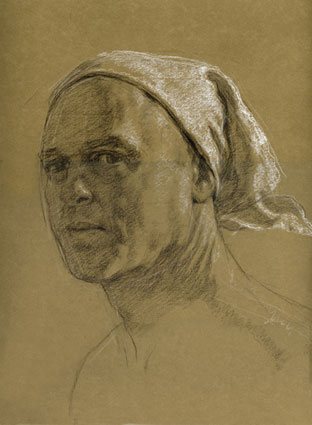I was recently on the train with a friend who caught the
attention of an artist sitting across from us. She started drawing my pal. We
were thrilled! It was an exciting moment as we watched my friend's face appear
on the paper in front of us. As the artist went about her work, I observed her
in action–and then went home and did a little more research to pull together
these tips on how to draw people that might be useful.
 |
||
| Self Portrait by Jon deMartin, 2011, chalk drawing on toned paper, 17 x 14. |
Different lines are essential when drawing people–denoting
volume and light and dark means remembering the diversity of line. It can be
thick or thin, jagged or smooth-edged, dabbed and dotted or unbroken. Figuring
out how to draw someone's face with just line is a lesson in itself in how
useful and dynamic lines really are.
Move your hand–and the paper. I was initially surprised at
how often the artist drawing my friend would move around. But in hindsight,
this makes perfect sense. The gesture of our hand when staying in one place can
only change so much, so altering the position of the hand or the surface we are
drawing upon can help you get the marks you want.
You are not connecting the dots. My impulse is always to
draw people starting with a bold outline that goes all around their body or
face. But that's an elementary urge, and in reality I don't need a rigid
enclosed outline to create dynamic drawings of people. I can use intermittent
lines, marking the nose or the hand for example, and the viewer's eye will
often fill in the rest.
 |
||
| Julie in Profile by Jon deMartin, 2009, chalk drawing on toned paper, 24 x 18. |
Crosshatching is never extreme. When I first learned about
crosshatching, my teacher reinforced again and again that it should never be
too crossed. What I mean is that the two lines of the mark should not be drawn
perpendicular to each other so you have a true "+." Instead, the lines of a
crosshatch are usually at a much more acute angle to each other.
This is only the tip of the iceberg of what it takes to
learn how to draw a person, but it's definitely a place to start. For more
in-depth instruction on drawing people, consider the Anniversary Edition of Drawing People. Enjoy!

SOURCE: Artist Daily – Read entire story here.